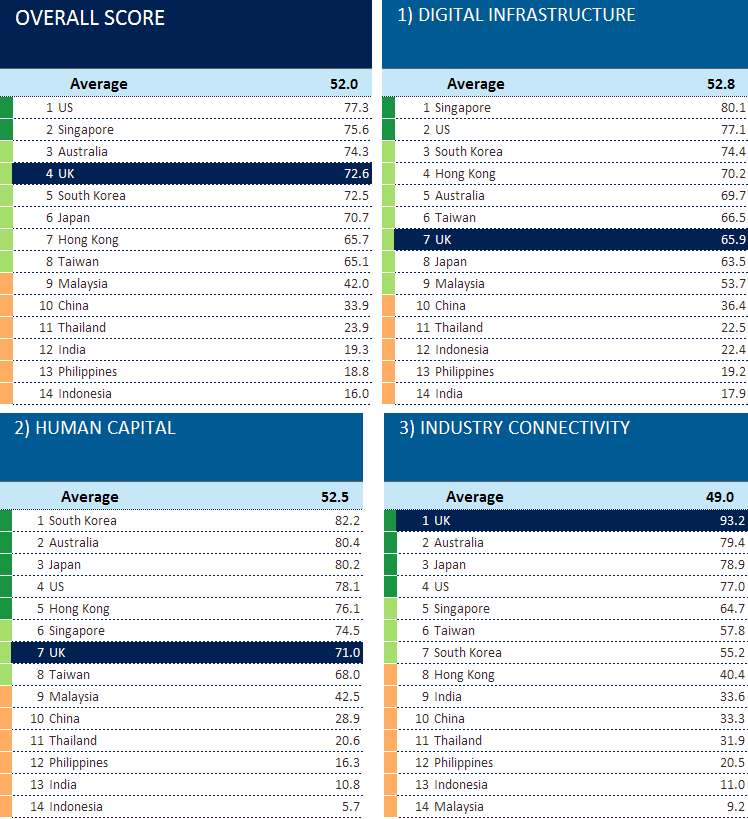Asian Digital Infrastructure Report Highlights Weak UK Investment
A recent ‘Connecting Capabilities’ report from the Economist Intelligence Unit, which pits the UK, USA and Australia against 11 countries in Asia, has revealed that the UK sits mid-table (ranked 7th) for Digital Infrastructure and is being pulled down by weak telecoms investment. But it’s not all bad.
The ranking forms part of the EIU’s new Asian Digital Transformation Index, which looks at the connectivity capabilities (broadband, mobile etc.) of each country and examines how those technologies are being used, as well as their impact upon the wider economy and public sector. Various other factors, such as levels of investment, ICT friendly laws, Internet use and public policy also play a part.
Overall the United Kingdom actually does quite well and is ranked 4th with a score of 72.6 out of 100. The strong position is largely because we come top for ‘Industry Connectivity‘, which is based on a country ranking that looks at areas including how many business have a website, the size of our e-commerce market, digital partnerships and the availability of government data through digital means.
Advertisement
Extract from the Report:
“While several Asian countries are performing well – in particular Singapore, South Korea and Japan – a comparison with western countries such as Australia, the UK and US shows that the region as a whole lags behind, in particular when it comes to digital infrastructure but also human capital. Although all companies across all geographies suffer from a lack of digital skills.”
However for us the main focus has to be on ‘Digital Infrastructure‘, which puts the UK in 7th position, albeit still ahead of big economies like Japan, Malaysia and China. In this category the UK is being pulled down by a lack of telecommunications investment as % of GDP (0.2% – lower than any other country in the ranking, all of which hovered around 0.3-0.6%) and the number of subsea communications cables (score 21 out of 100).
On the flip side we do reasonably well in other areas of Digital Infrastructure, such as broadband speeds (score 58 out of 100), ICT expenditure (77 out of 100), 4G coverage (89 out of 100) and so forth.

However we should say that the report is far from perfect and some of its data sources may not provide the most accurate reflection of local connectivity. For example, the data for 4G network coverage was gathered via a 2015 report from the ITU (very out of date) and it’s a similar story for the GDP figures, which would do little to reflect Virgin Media’s new £3bn Project Lightning or similar work. In other areas some of the data is even sourced from as far back as 2014 (in technology terms, a lot can change in 2-3 years).
Advertisement
Likewise the information on broadband speeds was extracted from Akamai’s 2016 “State of the Internet” report (it doesn’t say what quarter of the year) and this arguably does more to showcase Akamai’s own CDN performance than actual end-user connection speeds. Looking at fixed line network availability might have been a better gauge. As such the ranking is interesting, but we wouldn’t put too much stock in all of its scores.
Microsoft Excel Data
http://connectedfuture.economist.com/data.xlsm
Mark is a professional technology writer, IT consultant and computer engineer from Dorset (England), he also founded ISPreview in 1999 and enjoys analysing the latest telecoms and broadband developments. Find me on X (Twitter), Mastodon, Facebook, BlueSky, Threads.net and Linkedin.
« UK ISP BT Finally Launches Free Service to Cull Nuisance Phone Calls

















































Comments are closed